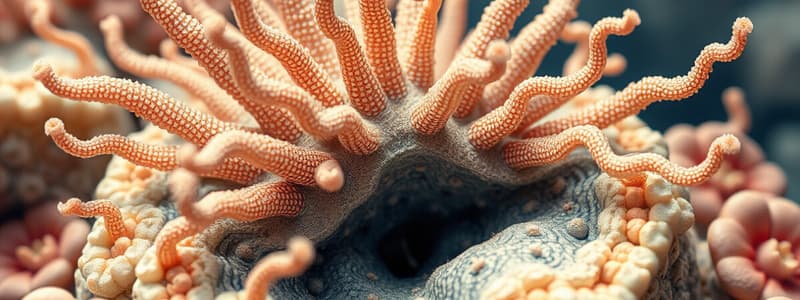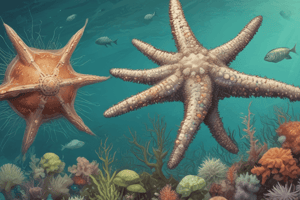Podcast
Questions and Answers
The madreporite and anus are both located on the -------- surface of a starfish.
The madreporite and anus are both located on the -------- surface of a starfish.
aboral
What is a pincher-like structure that keeps the surface of some echinoderms free of organisms?
What is a pincher-like structure that keeps the surface of some echinoderms free of organisms?
pedicellarie
What are the network of water-filled canals found only in echinoderms that provide water pressure to run the tube feet?
What are the network of water-filled canals found only in echinoderms that provide water pressure to run the tube feet?
Water Vascular System
The mouth, tube feet, and ambulacral groove are all located on the ------ surface.
The mouth, tube feet, and ambulacral groove are all located on the ------ surface.
Starfish have -------- fertilization; that means sperm and egg join outside the body in the ocean.
Starfish have -------- fertilization; that means sperm and egg join outside the body in the ocean.
The ---------- encircles the starfish's mouth and connects the stone canal to the radial canals in the arms.
The ---------- encircles the starfish's mouth and connects the stone canal to the radial canals in the arms.
All echinoderms are ------; that means they live in oceans (salt water).
All echinoderms are ------; that means they live in oceans (salt water).
The ----------- connects the madreporite to the ring canal.
The ----------- connects the madreporite to the ring canal.
The nerve that encircles the mouth of a starfish is called the -------.
The nerve that encircles the mouth of a starfish is called the -------.
Starfish have ---------- which make bile and absorb nutrients just like clams do.
Starfish have ---------- which make bile and absorb nutrients just like clams do.
The ---------- stomach stays inside the body in a starfish and is connected to the digestive glands and anus.
The ---------- stomach stays inside the body in a starfish and is connected to the digestive glands and anus.
What are small calcium carbonate plates that make up the endoskeleton of an echinoderm?
What are small calcium carbonate plates that make up the endoskeleton of an echinoderm?
Pigmented eyespots on the tips of each starfish arm can sense what?
Pigmented eyespots on the tips of each starfish arm can sense what?
Echinoderms have a winged larva called a --------.
Echinoderms have a winged larva called a --------.
The name echinoderm comes from the Latin word meaning?
The name echinoderm comes from the Latin word meaning?
What is a trench that runs along the ventral surface of the starfish's arms and holds the tube feet?
What is a trench that runs along the ventral surface of the starfish's arms and holds the tube feet?
What stomach is closest to the mouth and is extruded outside the body during feeding?
What stomach is closest to the mouth and is extruded outside the body during feeding?
What is the sieve-like opening into the water vascular system on the aboral surface of a starfish called?
What is the sieve-like opening into the water vascular system on the aboral surface of a starfish called?
What are small flexible fluid-filled tubes found on the oral surface that are used in locomotion, grabbing food, and gas exchange?
What are small flexible fluid-filled tubes found on the oral surface that are used in locomotion, grabbing food, and gas exchange?
Echinoderms are ---------------------- because even though they have no backbone, their blastopore becomes their anus.
Echinoderms are ---------------------- because even though they have no backbone, their blastopore becomes their anus.
The larva in a starfish has ------ symmetry.
The larva in a starfish has ------ symmetry.
Adult seastars have -------- symmetry.
Adult seastars have -------- symmetry.
------------ symmetry is a special kind of radial symmetry seen in 5-armed starfish.
------------ symmetry is a special kind of radial symmetry seen in 5-armed starfish.
Starfish have ---------, the ability to "self-amputate" body parts, which they can use to escape predators.
Starfish have ---------, the ability to "self-amputate" body parts, which they can use to escape predators.
The ability to regrow lost body parts is called ----------.
The ability to regrow lost body parts is called ----------.
The bulb-like sac at the base of the tube foot, which squeezes to control the amount of water moving in the foot, is called an ---------.
The bulb-like sac at the base of the tube foot, which squeezes to control the amount of water moving in the foot, is called an ---------.
Echinoderms have an ------------ inside their body made of ossicles.
Echinoderms have an ------------ inside their body made of ossicles.
Match the following structures with their functions:
Match the following structures with their functions:
Match the following body parts with their locations:
Match the following body parts with their locations:
Match the following terms with their definitions:
Match the following terms with their definitions:
Flashcards are hidden until you start studying
Study Notes
Echinoderm Anatomy and Physiology
- Madreporite and anus located on the aboral surface of a starfish.
- Structures called pedicellariae keep echinoderm surfaces free from organisms.
- The Water Vascular System consists of canals providing pressure to operate tube feet.
- Mouth, tube feet, and ambulacral groove are located on the oral surface.
- Starfish undergo external fertilization, allowing sperm and egg to join in ocean water.
- Ring canal surrounds the starfish's mouth, linking the stone canal to radial canals in its arms.
- All echinoderms are marine, adapted to life in saltwater environments.
- Stone canal connects the madreporite to the ring canal.
- The nerve ring encircles a starfish's mouth, coordinating movement and responses.
- Digestive glands in starfish produce bile and aid in nutrient absorption.
- The pyloric stomach stays internal, connected to digestive glands and anus.
- Echinoderm endoskeleton consists of ossicles, small calcium carbonate plates.
- Pigmented eyes on starfish arms sense light and dark.
- The larval form of echinoderms is known as bipinnaria.
Echinoderm Classification and Features
- The term echinoderm originates from Latin, meaning "spiny skin."
- Ambulacral groove runs along the ventral surface of arms, housing the tube feet.
- The cardiac stomach is extruded outside the body during feeding.
- Madreporite serves as the sieve-like opening to the water vascular system on the aboral surface.
- Tube feet, fluid-filled structures on the oral surface, are used for locomotion, food grasping, and gas exchange.
- Echinoderms are classified as invertebrate deuterostomes, where the blastopore becomes the anus.
- Starfish larvae exhibit bilateral symmetry, while adults display radial symmetry.
- Pentameral symmetry characterizes the radial symmetry in five-armed starfish.
Echinoderm Regeneration and Adaptability
- Autonomy refers to the ability of starfish to self-amputate body parts for predator avoidance.
- The process of regrowing lost body parts is called regeneration.
- The ampulla, a bulb-like sac at the base of tube feet, regulates water movement in the foot.
- Echinoderms possess an endoskeleton made of ossicles that provides structural support.
- The radial nerve and radial canal are found within the ambulacral ridge, contributing to function and movement.
- Fleshy skin extensions near starfish spines, known as skin gills, are involved in gas exchange, nitrogen waste excretion, and osmoregulation.
Studying That Suits You
Use AI to generate personalized quizzes and flashcards to suit your learning preferences.




